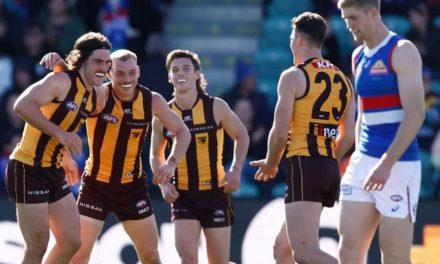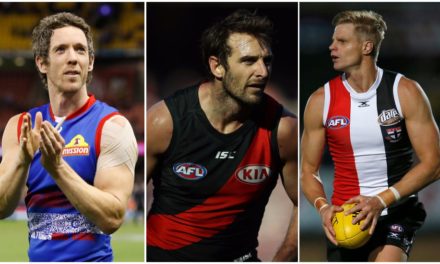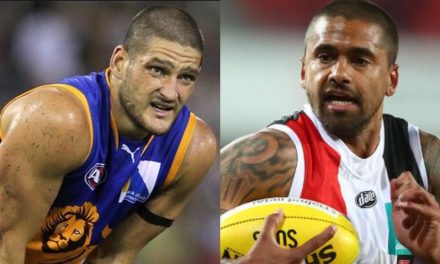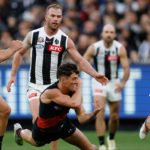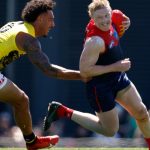Easton Wood and Bob Murphy show off the 2016 premiership cup at the Bulldogs’ Whitten Oval home. Photo: AAP
Melbourne and the Western Bulldogs simultaneously endured decades without success, defined by abject failure on the field with a smattering of near misses, and existential threats off it.
Rare finals appearances were accompanied by heartbreak and tears, from the late Jim Stynes’ infamous run through the mark to Tony Liberatore’s premature celebration and Rohan Smith’s slapping of the MCG turf.
When the Bulldogs finally broke the cycle and claimed a fairytale flag five years ago, they left Melbourne with the competition’s longest active premiership drought.
As well as the coveted piece of silverware now in their possession, they’ve long had something else the Demons have craved – a home.
In an age where clubs are run like businesses and fans are effectively seen as consumers, a stroll down Sutton Way past the Ted Whitten statue into the ground that now bears the latter legend’s name can offer a window to the past.
More so than any of their Victorian rivals’ headquarters, the Bulldogs’ long-time base gives off a real “football club” vibe. It has a soul that you can not only reach out and touch, but choose to be at the very heart of on a daily basis – and is accessible to all supporters.
The club formerly known as Footscray, blue-collar to the core, is one that doesn’t let anyone forget where it’s come from or what it’s been through. Tins that were rattled by desperate fundraisers in 1989 sit proudly on display in the entrance, next to a mock Fitzroy Bulldogs merger jumper and stickers emblazoned with the “Up Yours Oakley” rally cry.
There are tributes to the club’s Indigenous history and fallen war heroes, and displays of quirky memorabilia, from old gym bags and membership tickets to pairs of players’ boots and homemade scarves. A quick trip from the aptly named Barkers Cafe to the merchandise store – where you can still buy used Sherrin footballs that the AFL team has kindly kicked in – can take half an hour if you get stuck reading about the early 20th century animosity between arch rivals Footscray and Williamstown.
A trophy cabinet that could look almost barren is, in fact, in need of more shelves. The litany of prizes from minor successes might not scream “power club”, but displays a sense of pride in the club’s history. The men’s 1954 VFL and 2016 AFL premiership cups sit prominently, flanking the women’s 2018 AFLW version, which is displayed boldly in the middle.
PLEASE HELP US CONTINUE TO THRIVE BY BECOMING AN OFFICIAL FOOTYOLOGY PATRON. JUST CLICK THIS LINK.
The playing arena is now mostly green, rather than covered in Western Oval mud, yet, in keeping with its surroundings, it’s still a little rough around the edges. Looking over it, the old EJ Whitten Stand also bears the names of former Bulldog champions Allan Hopkins, Norman Ware, Arthur Olliver, Charlie Sutton and John Schultz. On AFLW match days, the stand is buzzing and the red-and-blue benches filled with fans young and old.
Supporters, families, community groups, university students, club staff, players (past and present) and other visitors gather daily in the cafe and mingle. On October 2, 2016 – the day after the Bulldogs completed their famous climb from seventh to premiers with a grand final triumph over Sydney – an estimated 30,000 fans piled into Whitten Oval to continue the celebrations after the previous night’s party on Barkly Street.
If Melbourne was to win the flag this year – assuming September’s COVID-19 restrictions allowed them to gather – where would be the Demon fans’ natural meeting place? Outside the MCG? Gosch’s Paddock? AAMI Park? Fifty kilometres away at Casey Fields?
Melbourne currently has its football department and administration split between those four locations, and it has been a similar story for decades. In the ‘90s, the Demons had a share of facilities at the MCG, St Kilda’s Junction Oval and a social club at Sandringham. The spread was part of the reason a merger with Glenferrie Oval-based Hawthorn was considered attractive by so many members.
More recently, the Melbourne board tried to address the issue and turn the Demons into a “big club” with first-class facilities under one roof.
A plan to claim part of Yarra Park for a base next to the MCG and Jolimont Station was shut down by angry locals and the state government in 2018. Other sites at Fisherman’s Bend and Burnley were also considered, but none came to fruition.
The Demons could feasibly build a brand new facility at Casey Fields, as Essendon have done at Tullamarine and Hawthorn are in the process of erecting at Dingley. But their sights are firmly set on an inner-city location, with a decision supposedly set to be made by 2023.
Melbourne, Australian football’s oldest club, has a rich history, legends and a long-suffering, yet dedicated, supporter base. It doesn’t lack soul or a story. It just doesn’t have its own space in which to tell it and add the next chapter.
Fortunately for Simon Goodwin’s men and the aforementioned fans, that doesn’t preclude winning that elusive premiership this season. But there are other hurdles to overcome in that pursuit, such as the Bulldogs at Marvel Stadium this Friday night.


